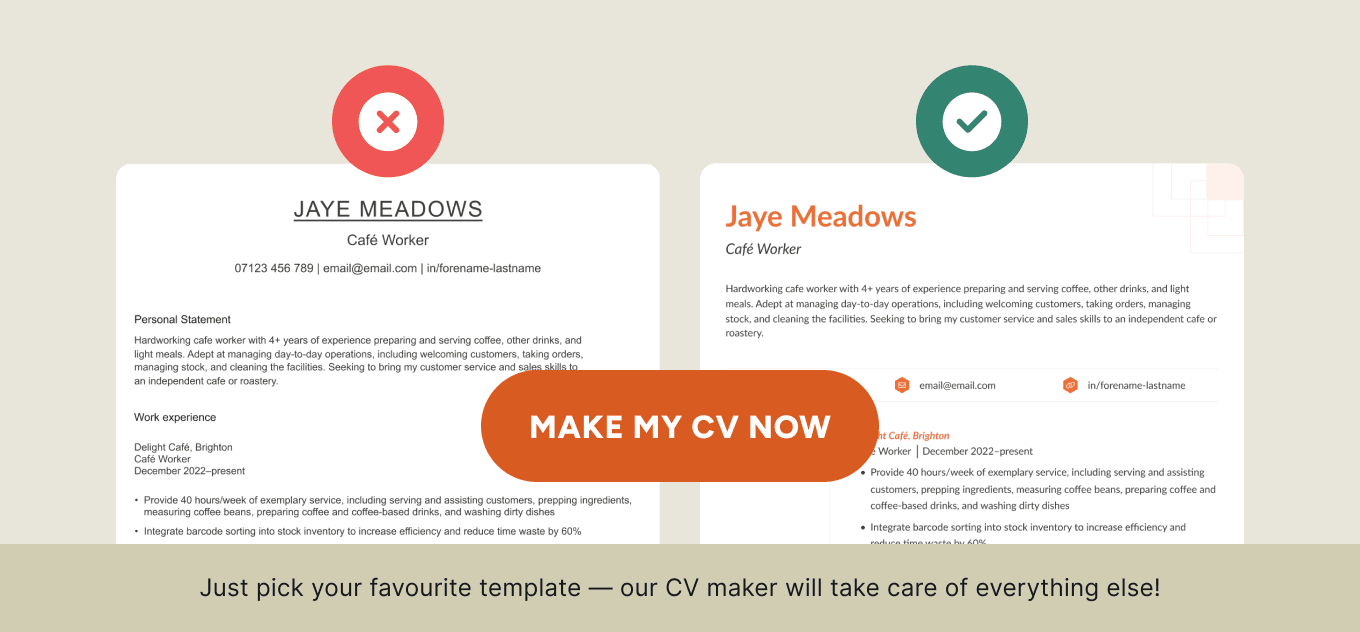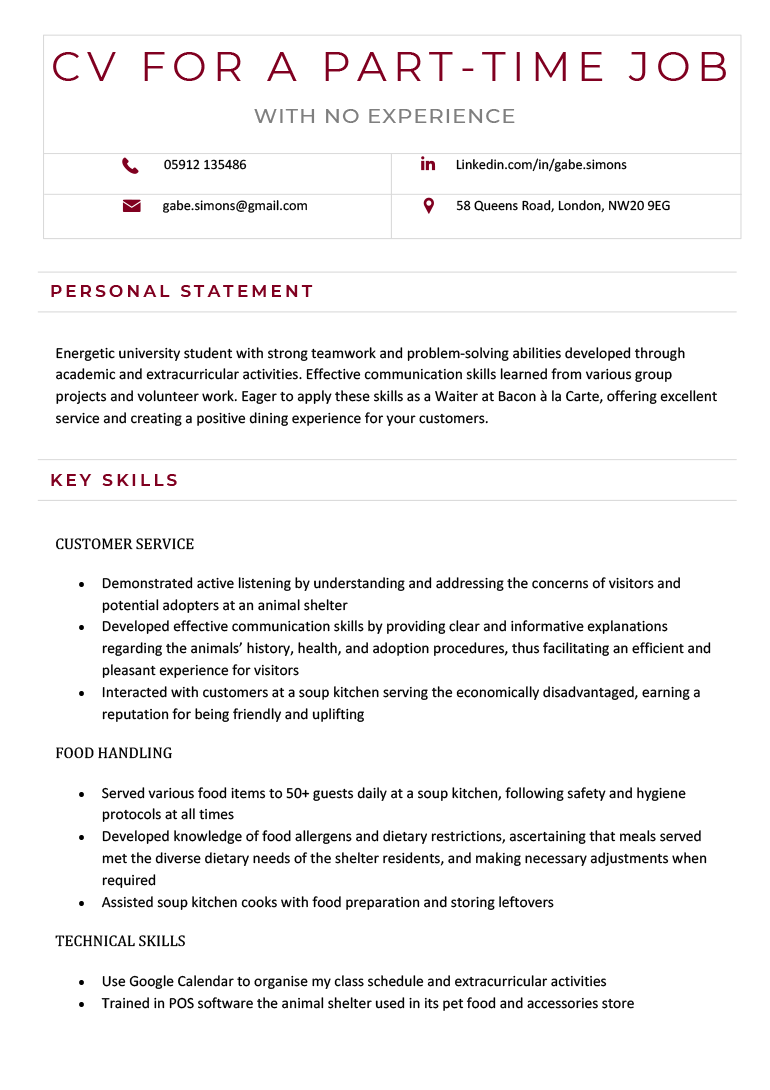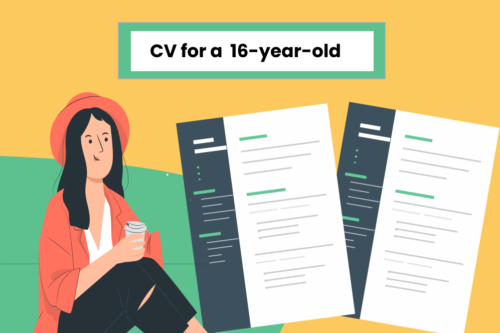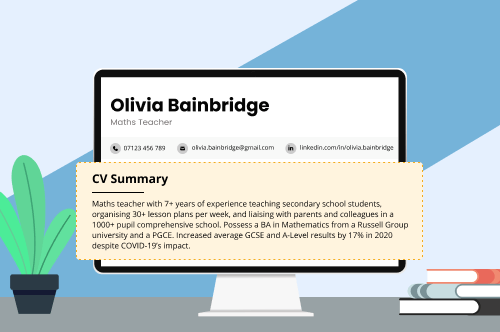Getting a part-time job is a great way to earn some spending money as a student or generate extra income as a professional with a full-time job. But before you can reap the financial rewards of a part-time job, you’ll need to write a CV that makes your target employer interested in hiring you.
Below we show you examples of good part-time job CVs and then take you through writing your CV for part-time work:
CV for part-time job examples & templates
Here are part-time job CV examples (and copy/paste templates) for:
1. Part-time job CV for students and teenagers with no work experience
Here’s an example of CV layout for a part-time job written by a university student — who has no work experience — looking for restaurant work:
Download Part-Time Job CV Example
Part-Time Job CV With No Work Experience (Template)
YOUR NAME
Job Title/Student
Phone: xxxxx xxx xxx Email: your.name@email.com LinkedIn: linkedin.com/in/your-name Address: your town
PERSONAL STATEMENT
Write a few sentences explaining why you’re a good fit for the part-time job you want. Include relevant skills you’ve picked up from your time in school and university and any voluntary or internship experience you have. Also, state the job title and company name to customise your CV for your target part-time role.
KEY SKILLS
Most Relevant Skill
- Give examples of how you’ve used your skill at school or in voluntary/internship roles
- Use hard numbers where possible to show what kind of impact you made
- Write at least two bullets in each list
[Continue with your next most relevant skills]
EDUCATION
University, Location | Start Date – End Date
Degree / Degree Name (mention your degree classification for an honours degree)
Key modules studied: List your key or job-relevant modules here
Secondary School, Location | Start Date – End Date
A-Levels: List any A-Levels you achieved while in secondary school or college
GCSEs: Include all GCSEs you achieved A*–C (or 9–4) in, particularly English, Maths, and IT
VOLUNTARY/INTERNSHIP EXPERIENCE
Most Recent Role Title, Start Date – End Date (or ‘Present’ if current)
Organisation Name, Location
Earlier Role Title, Start Date – End Date
Organisation Name, Location
HOBBIES & INTERESTS
- List your interests that show how you’d be a good fit for the role
- To determine which of your hobbies to list, research the company online
- Include at least two bullets
The student above chose to write a skills based CV that substitutes a robust skills section for work experience. But if you do have relevant work experience, try to highlight that over your skills, as it will give you an advantage over applicants who have no professional background.
2. Part-time job CV for applicants with professional experience
The person who wrote this CV for a part-time retail job has previous work experience to highlight:
Download Part-Time Job CV Example
Part-Time Job CV With Work Experience (Template)
YOUR NAME
Job Title/Student
Phone: xxxxx xxx xxx Email: your.name@email.com LinkedIn: linkedin.com/in/your-name Address: your town
PERSONAL STATEMENT
Write a few sentences explaining why you’re a good fit for the part-time job you want. Include your job title and relevant skills and achievements from your current and/or past roles. Also, state the job title and company name to customise your CV for your target part-time job.
WORK EXPERIENCE
Most Recent Job Title
Employer Name / Location / Start Date – End Date
- Write a bulleted list of your responsibilities and achievements
- Include hard numbers to your bullet points to show your impact
Earlier Job Title
Employer Name / Location / Start Date – End Date
- List relevant accomplishments
- If you no longer perform this job, use past tense verbs to describe your experience
EDUCATION
University, Location | Start Date – End Date
Degree / Degree Name (mention your degree classification for an honours degree)
Key modules studied: List your key or job-relevant modules here
Secondary School, Location | Start Date – End Date
A-Levels: List any A-Levels you achieved while in secondary school or college
GCSEs: Include all GCSEs you achieved A*–C (or 9–4) in, particularly English, Maths, and IT
KEY SKILLS
- List several skills that would help you perform in your target part-time role
- Use exact keywords from the job description to increase your chances of getting the recruiter’s attention
HOBBIES & INTERESTS
- List your interests that show how you’d be a good fit for the role
- To determine which of your hobbies to list, research the company online
- Include at least two bullets
When you write a CV for a part-time job, take a look at examples of good CVs written for the specific industry you want to work in. Seeing what skills and experience other applicants highlight on their applications helps you decide what to include in your CV.
So here are examples of CVs for roles that employers often offer as part-time jobs:
How to write a CV for a part-time job in 7 steps
Whether you copied one of the part-time job CV templates above or are starting with a blank page, read on to find out how to format your CV to get UK employers’ attention in 7 quick steps below.
Or you can save time by using a CV maker that automatically writes and formats your information in minutes.
1. Get the details right
A great part-time job opening attracts a lot of applicants. So taking time to perfect your CV’s details is important to help you stand out as qualified.
Details to optimise include your CV’s:
- font: Use a professional CV font set between 10 and 12 points for easy reading.
- margins: Typically, the default margins in your writing program are fine, but if you need to adjust them to better fit the content on your part-time job CV, change them within 1.27 to 2.5 cm.
- spacing: The spaces between your text should be 1–1.5 lines. Anything above that range looks like university coursework, and anything below it makes your CV hard to read.
- scannability: In addition to following the above points, use headings, bullet points, and CV icons to help your important information stand out to skimming recruiters seeking to fill part-time roles.
Also, don’t send the same CV to every employer you apply to. Your outline should change according to the job advert. So move your information around in your CV’s structure to ensure the information most aligned with the employer’s requirements for their open part-time job is at or near the top of the first page.
For example, suppose you don’t have job-specific work experience, but you do have job-relevant skills from unrelated work or pursuing your interests. In that case, you should move your skills section above your work experience section.
2. Write an engaging personal statement
Regardless of what structure you use for your part-time job CV, your 3–5 sentence personal statement always goes at the top, under your CV header. This quick overview, if written well, encourages employers to take a close look at your application.
So carefully write your personal statement in a way that engages the reader with:
- your reason for applying for that particular part-time job
- your most role-relevant skills, experience, and achievements
- CV keywords from the job advert
This is an example of an engaging CV personal statement for a part-time job:
Energetic university student studying hospitality and looking to gain practical experience in the field. Regularly prepare meals for family gatherings of 30+ people, and recently received top marks in a food safety class. Excited to apply my amateur cooking skills as a Part-Time Cook at Phil’s Fish & Chips.
3. Describe your relevant work experience (or volunteer and internship roles)
If you’ve got relevant work experience, great! Using hard numbers to show your impact in the role, list your:
- company name and location
- dates worked there
- job title
- responsibilities and achievements in 2–5 bullets
But what if you don’t have any work experience to put on your CV for a part-time job? In that case, you can describe any volunteer or internship roles you’ve held. And if you can’t do that, just emphasise your skills like the applicant who wrote the first part-time job CV example above did.
Here are examples of how to write your experience entries — first a professional experience entry and then a volunteer experience entry:
4. Highlight your education
Even if you’re just applying for part-time work, employers in the UK want to know what level of education you’ve received. That information is a good indicator of whether you’re trainable or not.
So make an education section for your CV that lists your:
- degree and year you graduated (or the expected date)
- university name and location
- relevant modules
- secondary school name and location
- A-levels and GCSEs
- other education-related accomplishments — e.g., your extracurricular activities, awards, or class projects — if they’re relevant to the part-time job you want
This is how your education section might look on your CV for a part-time job:
5. List the right skills for your target part-time job
In addition to describing your job-specific skills in your personal statement and work experience section, list your skills — those that match the requirements listed in the job advert — in a dedicated section.
Employers want to see such a section on CVs they review because it’s easy to skim through to verify that you’re qualified for their part-time role. If they like what they see in your skills section, they’ll look carefully at the rest of your CV and your cover letter.
This is a good skills section for a part-time graphic design job:
Relevant Skills
- Photoshop and Figma (expert)
- Font design and pairing (expert)
- Premiere and Final Cut (intermediate)
6. Include your hobbies and interests
Even though you’ll just be a part-time worker, employers want you to fit well into their work culture. A good way to show that you’re a good culture fit is by making a hobbies and interests section that shows you’ll be an interesting addition to the team.
So before you list your interests, research the company’s website and social media profiles to get an idea of what type of culture they’re cultivating. Then, think about which of your leisure-time activities would best help you fit in.
For instance, if the company seems fun and relaxed, you could list your love of board games or mixology. But if your target employer presents a formal front, go with your professional interests, like blogging about your field of work or listening to industry-specific podcasts.
This is an example of a hobbies and interests section written for a part-time restaurant job CV:
Hobbies & Interests
- Cooking for family and friends
- Meeting new people at networking events
- Learning about fermentation
- Reading foodie blogs
7. Make a cover letter to explain your part-time job CV
Finally, don’t send off your part-time job CV without writing a cover letter that formally introduces you to the employer and explains why you’re interested in and suitable for the role you want.
Writing a detailed cover letter is especially important if you’re applying for part-time work on the side of a full-time career. In this situation, you may seem overqualified to employers, so you’ll need to assure them up front that you’ll be trainable and put in the effort their work deserves.
The most efficient way to make a job-winning cover letter is to use a good cover letter builder that uses AI to write and format your letter. But if you have time and want to write one from scratch, here are some cover letter writing resources to guide you:







